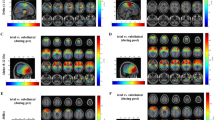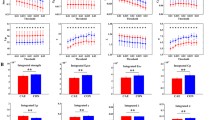Abstract
Using multi-frequency magnetoencephalography (MEG) data, we investigated whether the effective connectivity (EC) network of patients with childhood absence epilepsy (CAE) is altered during the inter-ictal period in comparison with healthy controls. MEG data from 13 untreated CAE patients and 10 healthy controls were recorded. Correlation analysis and Granger causality analysis were used to construct an EC network at the source level in eight frequency bands. Alterations in the spatial pattern and topology of the network in CAE were investigated by comparing the patients with the controls. The network pattern was altered mainly in 1–4 Hz, showing strong connections within the frontal cortex and weak connections in the anterior–posterior pathways. The EC involving the precuneus/posterior cingulate cortex (PC/PCC) significantly decreased in low-frequency bands. In addition, the parameters of graph theory were significantly altered in several low- and high-frequency bands. CAE patients display frequency-specific abnormalities in the network pattern even during the inter-ictal period, and the frontal cortex and PC/PCC might play crucial roles in the pathophysiology of CAE. The EC network of CAE patients was over-connective and random during the inter-ictal period. This study is the first to reveal the frequency-specific alteration in the EC network during the inter-ictal period in CAE patients. Multiple-frequency MEG data are useful in investigating the pathophysiology of CAE, which can serve as new biomarkers of this disorder.






Similar content being viewed by others
References
Bai X, Vestal M, Berman R et al (2010) Dynamic time course of typical childhood absence seizures: EEG, behavior, and functional magnetic resonance imaging. J Neurosci 30:5884–5893. doi:10.1523/JNEUROSCI.5101-09.2010
Bai X, Guo J, Killory B et al (2011) Resting functional connectivity between the hemispheres in childhood absence epilepsy. Neurology 76:1960–1967
Bartolomei F, Bosma I, Klein M et al (2006) Disturbed functional connectivity in brain tumour patients: evaluation by graph analysis of synchronization matrices. Clin Neurophysiol 117:2039–2049. doi:10.1016/j.clinph.2006.05.018
Benjamini Y, Hochberg Y (1995) Controlling the false discovery rate: a practical and powerful approach to multiple testing. J R Stat Soc B 57:289–300
Caplan R, Siddarth P, Stahl L et al (2008) Childhood absence epilepsy: behavioral, cognitive, and linguistic comorbidities. Epilepsia 49:1838–1846. doi:10.1111/j.1528-1167.2008.01680.x
Cerminara C, D’Agati E, Casarelli L et al (2013) Attention impairment in childhood absence epilepsy: an impulsivity problem? Epilepsy Behav 27:337–341. doi:10.1016/j.yebeh.2013.02.022
Coito A, Genetti M, Pittau F et al (2016) Altered directed functional connectivity in temporal lobe epilepsy in the absence of interictal spikes: a high density EEG study. Epilepsia. doi:10.1111/epi.13308
Collins DL, Neelin P, Peters TM, Evans AC (1994) Automatic 3D intersubject registration of MR volumetric data in standardized Talairach space. J Comput Assist Tomogr 18:192–205
Crone JS, Schurz M, Holler Y et al (2015) Impaired consciousness is linked to changes in effective connectivity of the posterior cingulate cortex within the default mode network. Neuroimage 110:101–109. doi:10.1016/j.neuroimage.2015.01.037
Engel J Jr, da Silva FL (2012) High-frequency oscillations—where we are and where we need to go. Prog Neurobiol 98:316–318. doi:10.1016/j.pneurobio.2012.02.001
Evans AC, Janke AL, Collins DL, Baillet S (2012) Brain templates and atlases. Neuroimage 62:911–922. doi:10.1016/j.neuroimage.2012.01.024
Friston KJ (2011) Functional and effective connectivity: a review. Brain Connect 1:13–36. doi:10.1089/brain.2011.0008
Gupta D, Ossenblok P, van Luijtelaar G (2011) Space–time network connectivity and cortical activations preceding spike wave discharges in human absence epilepsy: a MEG study. Med Biol Eng Comput 49:555–565. doi:10.1007/s11517-011-0778-3
Hyett MP, Breakspear MJ, Friston KJ, Guo CC, Parker GB (2015) Disrupted effective connectivity of cortical systems supporting attention and interoception in melancholia. JAMA Psychiatry 72:350–358. doi:10.1001/jamapsychiatry.2014.2490
Killory BD, Bai X, Negishi M et al (2011) Impaired attention and network connectivity in childhood absence epilepsy. Neuroimage 56:2209–2217. doi:10.1016/j.neuroimage.2011.03.036
Korzeniewska A, Cervenka MC, Jouny CC et al (2014) Ictal propagation of high frequency activity is recapitulated in interictal recordings: effective connectivity of epileptogenic networks recorded with intracranial EEG. Neuroimage 101:96–113. doi:10.1016/j.neuroimage.2014.06.078
Kruschwitz JD, List D, Waller L, Rubinov M, Walter H (2015) GraphVar: a user-friendly toolbox for comprehensive graph analyses of functional brain connectivity. J Neurosci Methods 245:107–115. doi:10.1016/j.jneumeth.2015.02.021
Li Q, Cao W, Liao X et al (2015) Altered resting state functional network connectivity in children absence epilepsy. J Neurol Sci 354:79–85. doi:10.1016/j.jns.2015.04.054
Liao W, Zhang Z, Pan Z et al (2010) Altered functional connectivity and small-world in mesial temporal lobe epilepsy. PLoS One 5:e8525. doi:10.1371/journal.pone.0008525
Lopes da Silva F, Blanes w, Kalitzin S (2003) Epilepsies as dynamical diseases of brain systems: basic models of the transition between normal and epileptic activity. Epilepsia 44:72–83
Luo C, Li Q, Lai Y et al (2011) Altered functional connectivity in default mode network in absence epilepsy: a resting-state fMRI study. Hum Brain Mapp 32:438–449. doi:10.1002/hbm.21034
Luttjohann A, van Luijtelaar G (2012) The dynamics of cortico-thalamo-cortical interactions at the transition from pre-ictal to ictal LFPs in absence epilepsy. Neurobiol Dis 47:49–60. doi:10.1016/j.nbd.2012.03.023
Meeren HK, Pijn JP, Van Luijtelaar EL (2002) Cortical focus drives widespread corticothalamic networks during spontaneous absence seizures in rats. J Neurosci 22:1480–1495
Muller A, Kraemer JF, Penzel T, Bonnemeier H, Kurths J, Wessel N (2016) Causality in physiological signals. Physiol Meas 37:R46–R72. doi:10.1088/0967-3334/37/5/R46
Panayiotopoulos CP (1999) Typical absence seizures and their treatment. Arch Dis Child 81:351–355. doi:10.1136/adc.81.4.351
Ponsen MM, Stam CJ, Bosboom JL, Berendse HW, Hillebrand A (2012) A three dimensional anatomical view of oscillatory resting-state activity and functional connectivity in Parkinson’s disease related dementia: an MEG study using atlas-based beamforming. Neuroimage Clin 2:95–102. doi:10.1016/j.nicl.2012.11.007
Ponten SC, Bartolomei F, Stam CJ (2007) Small-world networks and epilepsy: graph theoretical analysis of intracerebrally recorded mesial temporal lobe seizures. Clin Neurophysiol 118:918–927. doi:10.1016/j.clinph.2006.12.002
Reijneveld JC, Ponten SC, Berendse HW, Stam CJ (2007) The application of graph theoretical analysis to complex networks in the brain. Clin Neurophysiol 118:2317–2331. doi:10.1016/j.clinph.2007.08.010
Rubinov M, Sporns O (2010) Complex network measures of brain connectivity: uses and interpretations. Neuroimage 52:1059–1069. doi:10.1016/j.neuroimage.2009.10.003
Rubinov M, Sporns O (2011) Weight-conserving characterization of complex functional brain networks. Neuroimage 56:2068–2079. doi:10.1016/j.neuroimage.2011.03.069
Rubinov M, Knock SA, Stam CJ, Micheloyannis S, Harris AW, Williams LM, Breakspear M (2009) Small-world properties of nonlinear brain activity in schizophrenia. Hum Brain Mapp 30:403–416. doi:10.1002/hbm.20517
Sauseng P, Klimesch W (2008) What does phase information of oscillatory brain activity tell us about cognitive processes? Neurosci Biobehav Rev 32:1001–1013. doi:10.1016/j.neubiorev.2008.03.014
Schmidt C, Pester B, Schmid-Hertel N, Witte H, Wismuller A, Leistritz L (2016) A multivariate granger causality concept towards full brain functional connectivity. PLoS One 11:e0153105. doi:10.1371/journal.pone.0153105
Schoonheim MM, Geurts JJ, Landi D et al (2013) Functional connectivity changes in multiple sclerosis patients: a graph analytical study of MEG resting state data. Hum Brain Mapp 34:52–61. doi:10.1002/hbm.21424
Stam CJ, Reijneveld JC (2007) Graph theoretical analysis of complex networks in the brain. Nonlinear Biomed Phys 1:3. doi:10.1186/1753-4631-1-3
Stam CJ, de Haan W, Daffertshofer A et al (2009) Graph theoretical analysis of magnetoencephalographic functional connectivity in Alzheimer’s disease. Brain 132:213–224. doi:10.1093/brain/awn262
Supekar K, Musen M, Menon V (2009) Development of large-scale functional brain networks in children. PLoS Biol 7:e100057. doi:10.1371/journal.pbio.1000157
Tang L, Xiang J, Huang S et al (2015) Neuromagnetic high-frequency oscillations correlate with seizure severity in absence epilepsy. Clin Neurophysiol. doi:10.1016/j.clinph.2015.08.016
Tenney JR, Fujiwara H, Horn PS, Jacobson SE, Glauser TA, Rose DF (2013) Focal corticothalamic sources during generalized absence seizures: a MEG study. Epilepsy Res 106:113–122. doi:10.1016/j.eplepsyres.2013.05.006
Tenney JR, Fujiwara H, Horn PS, Vannest J, Xiang J, Glauser TA, Rose DF (2014) Low- and high-frequency oscillations reveal distinct absence seizure networks. Ann Neurol 76:558–567. doi:10.1002/ana.24231
Vaudano AE, Laufs H, Kiebel SJ et al (2009) Causal hierarchy within the thalamo-cortical network in spike and wave discharges. PLoS One 4:e6475. doi:10.1371/journal.pone.0006475
Verrotti A, Matricardi S, Rinaldi VE, Prezioso G, Coppola G (2015) Neuropsychological impairment in childhood absence epilepsy: review of the literature. J Neurol Sci 359:59–66. doi:10.1016/j.jns.2015.10.035
Wang C, Xu J, Zhao S, Lou W (2016) Graph theoretical analysis of EEG effective connectivity in vascular dementia patients during a visual oddball task. Clin Neurophysiol 127:324–334. doi:10.1016/j.clinph.2015.04.063
Westmijse I, Ossenblok P, Gunning B, van Luijtelaar G (2009) Onset and propagation of spike and slow wave discharges in human absence epilepsy: a MEG study. Epilepsia 50:2538–2548. doi:10.1111/j.1528-1167.2009.02162.x
Wilke M, Holland SK, Altaye M, Gaser C (2008) Template-O-Matic: a toolbox for creating customized pediatric templates. Neuroimage 41:903–913. doi:10.1016/j.neuroimage.2008.02.056
Xiang J, Luo Q, Kotecha R et al. (2014) Accumulated source imaging of brain activity with both low and high-frequency neuromagnetic signals. Front Neuroinform 8:57. doi:10.3389/fninf.2014.00057
Xiang J, Korman A, Samarasinghe KM et al (2015a) Volumetric imaging of brain activity with spatial-frequency decoding of neuromagnetic signals. J Neurosci Methods 239:114–128. doi:10.1016/j.jneumeth.2014.10.007
Xiang J, Tenney JR, Korman AM et al (2015b) Quantification of interictal neuromagnetic activity in absence epilepsy with accumulated source imaging. Brain Topogr 28:904–914. doi:10.1007/s10548-014-0411-5
Xu CP, Zhang SW, Fang T et al. (2013) Altered functional connectivity within and between brain modules in absence epilepsy: a resting-state functional magnetic resonance imaging study. Biomed Res Int 2013:734893. doi:10.1155/2013/734893
Ye AX, Leung RC, Schafer CB, Taylor MJ, Doesburg SM (2014) Atypical resting synchrony in autism spectrum disorder. Hum Brain Mapp 35:6049–6066. doi:10.1002/hbm.22604
Acknowledgements
We thank the patients and their families for their time and support; the physicians and fellows at NBH and Nanjing Children’s Hospital for assistance in patient recruitment and MEG recording; and the MEG Center at Cincinnati Children’s Hospital for helping with MEG data analysis. This study was funded by the National Natural Science Foundation of China (Grant No. 81471324, http://npd.nsfc.gov.cn/), the Key Project of Medical Science and Technology Development Foundation (Grant No. ZKX11002, http://www.njh.gov.cn/html/list_83.shtml), the Fourth Phase of Jiangsu “Project 333” Scientific Research Funding Schemes, 2013, the Health Department of Jiangsu Province (Grant No. H201443) and the Nanjing Medical University General Programs (Grant No. 2014NJMU050 and Grant No. 2015NJMU109).
Author information
Authors and Affiliations
Corresponding author
Ethics declarations
Conflict of interest
The authors declare that no financial interest or benefit exist.
Electronic supplementary material
Below is the link to the electronic supplementary material.
Rights and permissions
About this article
Cite this article
Wu, C., Xiang, J., Jiang, W. et al. Altered Effective Connectivity Network in Childhood Absence Epilepsy: A Multi-frequency MEG Study. Brain Topogr 30, 673–684 (2017). https://doi.org/10.1007/s10548-017-0555-1
Received:
Accepted:
Published:
Issue Date:
DOI: https://doi.org/10.1007/s10548-017-0555-1




